Comments / Questions (69)
![]() Ingrid wrote:
Ingrid wrote:
Hallo, ik ben met het leuke mutsje bezig en na een paar mislukte pogingen gaat het nu heel goed. Wat ik alleen nog niet begrijp is hoe de afwerking nu precies gaat. Ik moet de achterkant aan elkaar maken, maar tot 2 cm onder het blaadjes patroon? Waarom niet tot de onderkant, past het dan niet? En ik snap niet helemaal hoe ik dan de touwtjes moet beginnen.
30.11.2025 - 15:31DROPS Design answered:
Dag Ingrid,
Je laat aan de achterkant een split open, waar koorden aan komen om het mutsje vast te knopen.
30.11.2025 - 15:51
![]() Ute wrote:
Ute wrote:
Ich bin mit der Mütze soweit fertig, das ich die Bindebänder stricken kann. Diese werden ja nun wenn ich das richtig verstehe am Abkettrand hinten an der Öffnung gestrickt. Bedeutet das, dass die Mütze später auch nach hinten zugebunden wird?🤔
15.09.2025 - 14:06DROPS Design answered:
Liebe Ute, die Bindebänder sollen so lang sein, dass sie vorne zugebunden werden können.
17.09.2025 - 09:58
![]() Marta wrote:
Marta wrote:
Jestem początkująca i mam problem ze wzorem . Czy jedna kratka we wzorze oznacza jeden rządek, czy dwa (lewa plus prawa strona)? Jak zrobić narzut przed pierwszym oczkiem (drugi rządek)?
24.08.2025 - 12:25
![]() Beata wrote:
Beata wrote:
Trudno, ale chciałam pomóc . Może choć trochę te urywek wzoru coś rozjaśni 😄 albo zagmatwa
21.07.2025 - 18:00
![]() Beata wrote:
Beata wrote:
Widzę, że się zlewa w jeden ciąg...🥴
21.07.2025 - 17:58
![]() Beata wrote:
Beata wrote:
10. PPP+P+PPP powtórzyć 8razy =72 oczka 11. PPLLLLLPP powtórzyć 8razy=72 oczka 12. PPPP+P+PPPP powtórzyć 8razy =88 oczek 13. PPLLLLLLLPP powtórzyć 8razy= 88 oczek
21.07.2025 - 17:55
![]() Beata wrote:
Beata wrote:
Nabieramy 8 oczek Rząd 1. LEWE OCZKA = 8 oczek 2. +P +P +P +P +P +P +P +P = 16 OCZEK 3. PRAWE OCZKA = 16 oczek 4. P+P P+P P+P P+P P+P P+P P+P P+P = 23 OCZKA 5. PLP PLP PLP PLP PLP PLP PLP PLP =23 OCZKA 6. P+P+P P+P+P P+P+P P+P+P P+P+P P+P+P P+P+P P+P+P = 40 oczek 7. PLLLP PLLLP PLLLP PLLLP PLLLP PLLLP PLLLP PLLLP =40 oczek 8. PP+P+PP powtórzyć 8razy =56 oczek 9. PPLLLPP powtórzyć 8razy =56 oczek
20.07.2025 - 14:52
![]() Beata wrote:
Beata wrote:
Wzór przerobiony na bardziej zrozumiały ;) chyba !?! P = prawe oczko L = lewe oczko + narzut ,dobierane oczko (\) zdjąć oczko bez przerabiania jak na prawo nastepne przerobić na prawo i przełożyć to nie przerobione nad tym oczkiem przerobionym (/) przerobić dwa oczka razem na prawo
20.07.2025 - 14:51
![]() Beata wrote:
Beata wrote:
Cześć. Widzę że sporo osób ma problem w odczytaniu wzoru ,też w pierwszej chwili tak miałam ale przetłumaczyłam sobie " z polskiego na nasze" ;) . Mogłabym go udostępnić ale za mało znaków jest tu do wpisania . Ewentualnie podzielę opis na kilka komentarzy. Wzór jest prosty naprawdę. Pozdrawiam wszystkich Dziergaczy
20.07.2025 - 14:50
![]() Lina wrote:
Lina wrote:
Hue: Hvor masker har jeg efter pind 5 i str.18/24 mdr? Pind 6: er det korrekt forstået, at man strikker 1 ret, slå om, en ret, slå om, 1 ret (en rapport)?
03.07.2025 - 22:52DROPS Design answered:
Hei Lina. Du strikker A.1 9 ganger, og på pinne 5 består A.1 av 3 masker = 3 masker x 9 rapporter = 27 masker. Ja, 6. pinne = 1 ret, slå om, 1 ret, slå om, 1 ret (1 rapport). mvh DROPS Design
07.07.2025 - 09:50
Pink Petals Hat#pinkpetalshat |
||||||||||||||||||||||
 |
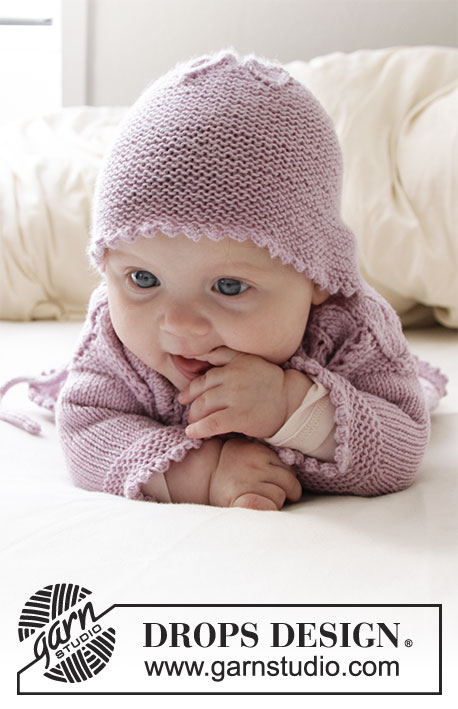 |
|||||||||||||||||||||
Knitted bonnet for babies with leaf pattern and garter stitch in DROPS BabyMerino. Sizes 0-24 months.
DROPS Baby 33-14 |
||||||||||||||||||||||
|
------------------------------------------------------- EXPLANATIONS FOR THE PATTERN: ------------------------------------------------------- RIDGE/GARTER STITCH (worked back and forth): Knit all rows. 1 ridge in height = Knit 2 rows. PATTERN: See diagram A.1. The diagram shows all rows in the pattern seen from the right side. ------------------------------------------------------- START THE PIECE HERE: ------------------------------------------------------- BONNET – SHORT OVERVIEW OF THE PIECE: The piece is worked back and forth with circular needle or double pointed needles, from mid back. Cast on 7-8-9 stitches with circular needle size 2.5 mm = US 1,5 and Baby Merino. Start from the wrong side and work A.1 back and forth (= 7-8-9 repeats of A.1). When A.1 has been completed there are 77-88-99 stitches on the needle. Insert 1 marker – THE PIECE IS NOW MEASURED FROM HERE! Work GARTER STITCH back and forth – see description above. When the piece measures 9-10-11 cm = 3½"-4"-4⅜" from the marker, bind off with a picot-edge as described below. BIND-OFF EDGE WITH PICOT: Bind off from the right side as follows: Knit 1, (* insert the right needle between the first 2 stitches on the left needle; i.e. between the stitches on the needle not through the stitches, make 1 yarn over the right needle and pull it between the 2 stitches and place it on the left needle *, work from *-* 2 more times, so there are 3 new stitches on the left needle. ** Knit the first stitch on the left needle, pass the first stitch on the right needle over the last stitch worked **), work from **-** a total of 5 times. Repeat from (-) along the whole edge until there is 1 stitch left on the left needle. Cut the strand and pull it through the last stitch. ASSEMBLY: Sew the bonnet together mid back, along A.1 – sew in the outermost loop of the outermost stitch so the seam is flat and continue the seam approx. 2 cm = ¾" along the garter stitch section. Cut and fasten the strand. TIE-CORDS: Work back and forth with 2 double pointed needles size 2.5 mm = US 1,5. Knit up 4 stitches on the one side of the bind-off edge. Knit 4, * do not turn the piece, but push the stitches to the other end of the needle, take the strand behind these 4 stitches, tighten and knit the 4 stitches again from the right side *, work from *-* until the cord measures 22-24-26 cm = 8¾"-9½"-10¼", bind off and fasten the strand. Work the other cord in the same way on the other side of the bind-off edge. |
||||||||||||||||||||||
Diagram explanations |
||||||||||||||||||||||
|
||||||||||||||||||||||
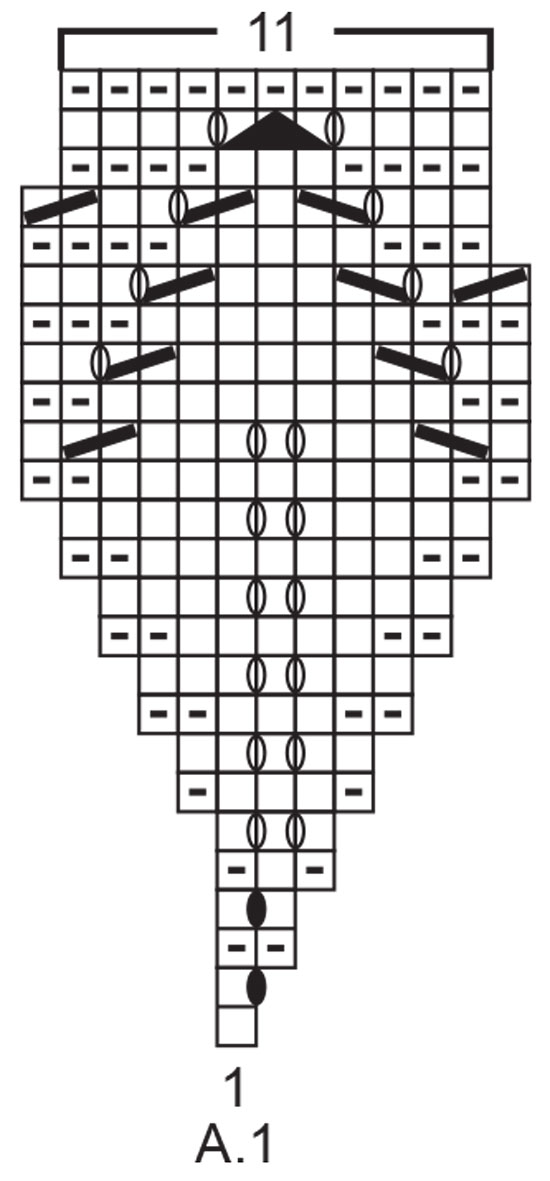 |
||||||||||||||||||||||
Have you finished this pattern?Tag your pictures with #dropspattern #pinkpetalshat or submit them to the #dropsfan gallery. Do you need help with this pattern?You'll find 18 tutorial videos, a Comments/Questions area and more by visiting the pattern on garnstudio.com. © 1982-2025 DROPS Design A/S. We reserve all rights. This document, including all its sub-sections, has copyrights. Read more about what you can do with our patterns at the bottom of each pattern on our site. |
||||||||||||||||||||||







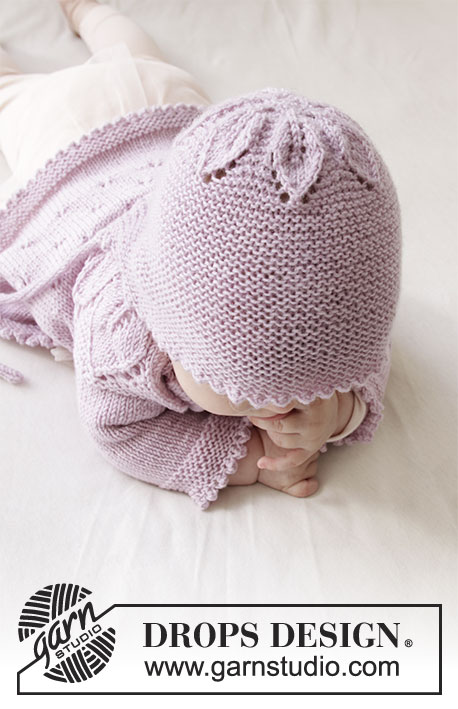
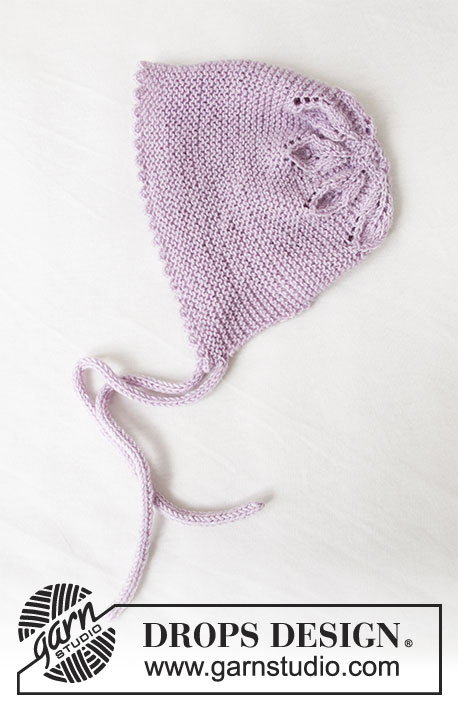


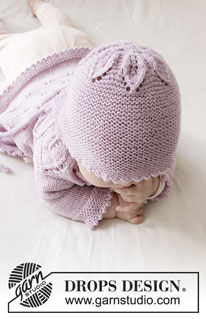
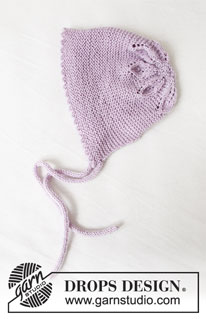






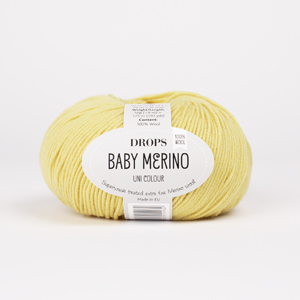
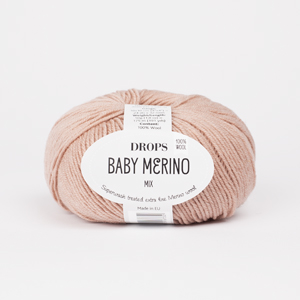







































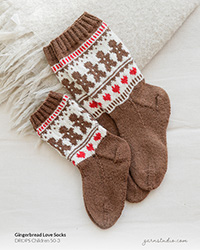
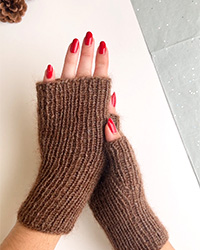
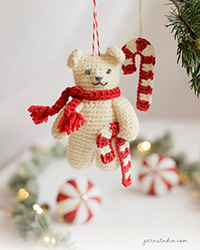
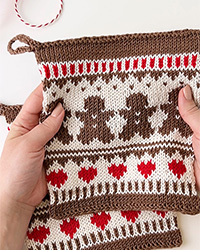
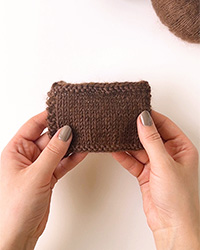

Post a comment to pattern DROPS Baby 33-14
We would love to hear what you have to say about this pattern!
If you want to leave a question, please make sure you select the correct category in the form below, to speed up the answering process. Required fields are marked *.